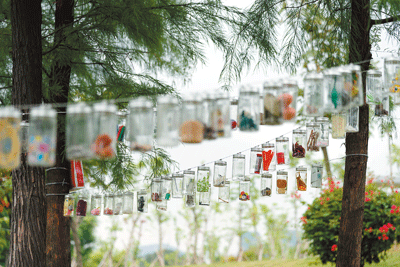 Cao Zhen caozhen0806@126.com SHENZHEN is known for its creative population, and one group of young Chinese artists are taking creativity to the next level. Stroll through Shenzhen Central Park, interact with some of the installations now on display and become part of the artwork. This is “Urban Implant,” an exhibition of sculptures and installations curated by Shenzhen Public Art Center. Curator Xia Hexing explained the “Urban Implant” theme by saying, “To implant is to insert a type of material into another one, to decorate or beautify something. Shenzhen used to be a fishing village and human beings inserted concrete buildings to turn it into a modern city. Then people built Central Park among the skyscrapers to create an artificial natural landscape inside the city. Do you think this process of transformation is ironic? We should think it over that after we get used to intervening and transforming nature and later want to get nature back — it is more difficult than before.” In its third year, the exhibition curators have more thoughts on the relationship between art and the public space. From installing the artwork in the park through the whole exhibition, the curators and the artists have been curious about the public’s reaction. “Exhibiting art in a public space, like this park, means the artists no longer have a monopoly over their works, or an exhaustive or total position over its interpretation or representation. It doesn’t mean the artists stop thinking or abandon individuality. It is a more common idea that the work itself has a life and we let viewers interpret it freely,” said Xia. Wang Haitong’s installation “No Rules, No Parks” appears to be an apt example of this concept of art as a living, changing being, with an audience that has the power to understand Wang’s creation. The artist placed three traffic lights along a wooden path in the park, creating what he described a conflict between rules and a free space. “The exhibition’s theme is ‘Urban Implant,’ so I inserted three traffic lights, the representation of rules on streets, into the park, which represents a free and relaxing environment,” Wang told the press during the opening of the exhibition Nov. 13. “I observed people’s reactions and it was funny when two cyclists in the park stopped when they saw a light turn red,” said Wang, who is pursuing a doctoral degree at China Academy of Art’s sculpture department. The most striking exhibit is Taiwan artist Lu Jia-i’s installation “Tailor-Made,” an array of 400-plus transparent bottles with various things inside them hung between trees in the park. Lu obtained the items, such as chestnuts, human hair, pencils, hairpins and even dust cloths, from friends and strangers during the past two years when she was in Taiwan and traveling in Hangzhou and Shenzhen. “Inside the bottles are articles of daily use given to me by the people I have met. Each bottle represents a person who is an individual with a free mind on the inside but displays homogeneity on the outside. Everyone is like a same industrial product in this modern society and hopes to escape from the institutionalized world to show one’s uniqueness,” said Lu, who obtained master of fine arts in 2013 from the plastic arts department of Da-Yeh University in Taiwan. She told Shenzhen Daily that she had exhibited “Tailor-Made” several times and she would continue to collect more items to broaden the piece. “During the exhibitions, some bottles disappear or some items rot. I accept that as part of the piece because in a public environment, everything should conform to changes and irreversible situations.” The art and public space concept can also be found in Luo Zhenhong’s sculpture “Mirage,” a building model in an inverted pyramid shape with a tiny base floor but a grand top. The sculpture, resembling a building model commonly seen at real estate promotional fairs, is placed in a traditional Chinese pavilion in the park with skyscrapers outside of the park as an ironical analog. Luo said the sculpture mimics the skyrocketing housing prices that are part of urbanization and the shocking inverted pyramid structure foresees the dangerous condition of our living space. “I chose a Chinese pavilion to place my sculpture to show the hybrid of ancient and modern, tradition and commerce. I wonder, when visitors enter this pavilion to take a break, what will they think? Will they regard this as a real estate company’s advertisement at first?” The exhibition also has an array of leisure sculptures and installations that evoke the harmony of art and nature. Fiber artist Ying Xinxun’s soft sculpture “Hugging Place,” a huge piece of cloth twined around trees, invites viewers to hug each other inside the cloth. Artist Qian Liang placed colorful disposable paper cups on the ground around a few tree trunks to form circles like rainbows in his installation “Disposable Rainbows.” “What makes the experience of using disposable paper cups pleasant is the fact that it’s convenient,” commented Shenzhen Public Art Center artist Zhang Kaiqin. “However, this surprising convenience makes disposable things ephemeral, like a rainbow. The artist hopes viewers will question whether this convenience should be achieved by consuming natural resources,” said Zhang. Dates: Until Dec. 17 Venue: Zone E, Shenzhen Central Park, intersection of Hongli and Huafu roads, Futian District (福田区红荔路与华富路交界深圳中心公园E区) Metro: Longgang Line, Huaxin Station (华新站), Exit D | 
